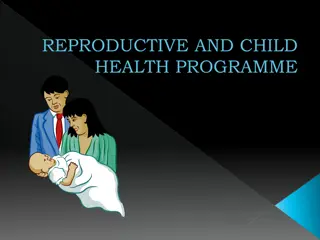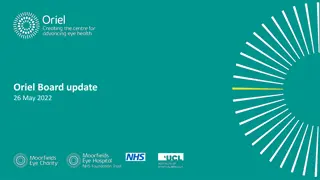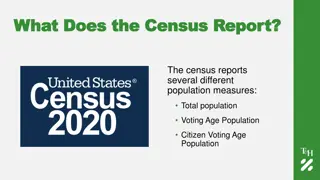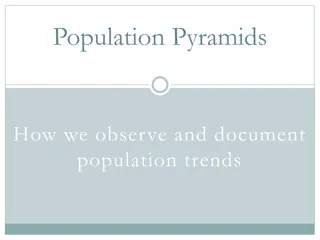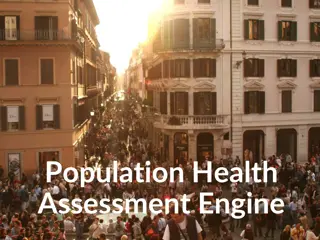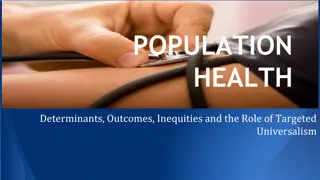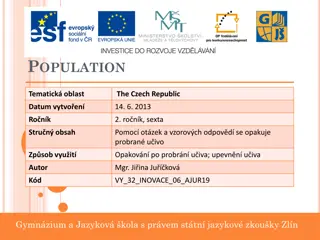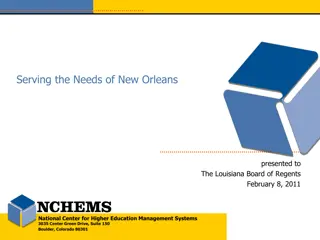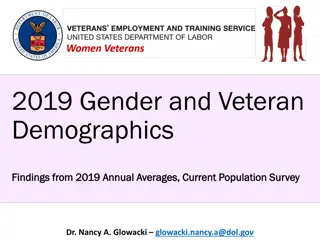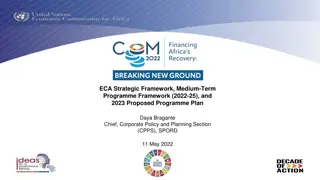Population Health Management Development Programme Overview
The Population Health Management Development Programme is a 22-week initiative aimed at enhancing the use of PHM techniques in systems, PCNs, and partners. Through tailored analytics, the programme focuses on advancing PHM infrastructure and improving outcomes for individuals. The agenda includes workshops, data analysis reviews, facilitated discussions, and virtual rounds to create a positive thinking environment. Join the programme to accelerate progress in PHM implementation and care delivery.
Download Presentation

Please find below an Image/Link to download the presentation.
The content on the website is provided AS IS for your information and personal use only. It may not be sold, licensed, or shared on other websites without obtaining consent from the author. Download presentation by click this link. If you encounter any issues during the download, it is possible that the publisher has removed the file from their server.
E N D
Presentation Transcript
Humber, Coast and Vale Population Health Management Development Programme Holderness Primary Care Home PCN ALS 1 30thSeptember 2020 NHS England and NHS Improvement
Action learning set 1 agenda: Time Item Lead 15 Mins Kate Howie, Chief Nurse, Optum Welcome and objectives An introduction to the workshop understand each others roles, share what is important to you and your PCN. 15 Mins Kate Howie Programme and ALS aims and objectives Recap of the programme aim, explore the role of the ALS in the context of the wider programme and how the team will work together. Agree teams ground rules 45 Mins James Ingamells, PHM Analyst, Optum Review and orientate to the data analysis for your population Understand how the PCN data was gathered and what it is telling us Review the PCN data packs 10 Mins Break 50 Mins All Facilitated Discussion What do you already know to be true and explore what else the insight is showing you Intervention development - Reflecting on current system working within each PCN through the eyes of local people: What could you do differently? 15 Mins Kate Howie Wrap-up, next steps and closure 2
Discussion: Creating a positive thinking environment Introduction to Virtual Rounds : The quality of everything we do depends on the quality of the thinking we do first; the quality of our thinking depends on the way we treat each other while we are thinking. Virtual rounds promotes equality of contribution and an intent focus on listening. Each person will get a set amount of time to contribute, uninterrupted, and then after a set amount of time we will take turns and give the next person an equivalent amount of time. 5 mins Start on a positive Introduce yourself and state something that happened this week that was positive (professionally or personally). 3
About the Population Health Management Development Programme A nationally funded intensive 22-week programme to enable systems, PCNs and partners to make faster progress in the use of PHM techniques. In each system, participating PCNs are supported to use tailored analytics to rapidly put PHM into practice during the 22 weeks. PCNs are fundamental to delivering the Development Programme s twin aims: Advance the system s PHM infrastructure and enable future use of PHM cycle Change care delivery to achieve better outcomes and experience for people
Summary of programme actions and timelines Educational Webinars/ Learning materials Case Study Place ALS PCN ALS System ALS KEY: c =System/Clinical Leadership Coaching Integrated Care Finance & Contracting ALS Spread and Scale (delivered via PHM steering groups) Segment Selection ALS (cross work stream) Analytics ALS Weeks 1 2 3 4 13 22 9 14 15 18 20 17 19 21 5 12 6 7 8 10 11 16 System ALS c c *Place/ICP ALS c c c c c c PCN ALS Integrated Care Finance & Contracting ALS Data & Analytics ALS We are here Scale and Spread: PHM capabilities Education *To note: IdeallyPlace/ICP ALS1 is held during week 5, however discussion needed with individual systems as to the feasibility of obtaining data and attendance required to conduct Place level analytics for week 5 start. 5
PCN cohort selection We have selected a cohort of people who [ ] and we think we can [ ]. Aspects to consider during intervention design: Our cohort selection criteria are: A. B. C. D. E. A. B. C. D. E. F. Thoughts on the wider determinants and health inequalities for this cohort: A. B. 6
Action Learning Sets support local design and implementation An Action Learning Set (ALS) is a structured way of bringing a group of people together to learn from each other. It is a process which involves working on real challenges and issues using the knowledge, skills and experiences of the group and working collectively to develop solutions. Benefits for members of an ALS include: Learning best practice Acquiring problem solving skills Having to articulate a challenge clearly and succinctly so that the whole ALS understands it Being challenged by the group Forming effective plans for immediate implementation Getting results in a constructive way Sustain momentum and encourage spread to other PCNs Working as a group, members can design and test interventions to proactively meet the needs of priority patient groups within their localities in a safe and supported environment. Suggested ALS Membership: Membership will vary according to your area of focus, but may includePCN clinical director, PCN PHM lead, PCN manager, any PCN members that may be included in care design and implementation such as Community and Mental Health partners, Acute representation, VCSE, Local Authority, Public Health, Analytical Lead and PHM steering committee lead.
Population Health Management Development Programme Holderness Primary Care Home PCN Analysis Pack 30th September 2020 NHS England and NHS Improvement
Table of Contents 1. Data, patient complexity & multimorbidity 2. Simple Segmentation incl. COVID risk & intersegmental drift 3. PCN & practice comparisons incl. wider determinants 4. Intelligent Segmentation 5. Risk Stratification 9
Table of Contents 1. Data, patient complexity & multimorbidity 2. Simple Segmentation incl. COVID risk & intersegmental drift 3. PCN & practice comparisons incl. wider determinants 4. Intelligent Segmentation 5. Risk Stratification 10
Linked data for Population Health Analytics General Practice Wider Acute Determinants 3 Years of: Linked, Costed, Segmented & stratified data The Person (population based on GP registered lists) Population Health Analytics tools Any others (police, housing, ambulance, 111 + others) Community Adult Social Care Mental Health 11
Theograph: Holderness Primary Care Home PCN Patient Detail Age: 85-90 Sex: Female IMD Decile: 7 ONS Area Classification: Suburban Living eFI Frailty Score: Severe Physical/Mental Health: Hypertension, Depression, Heart Failure Other Characteristics: Social vulnerable Total Utilisation 12 month period: c. 30k Theographs allow us to visualise the health journey of a single patient, across the entire continuum of health and care 12
Measuring patient complexity across HCV Complexity Segments based on the number of acute & chronic conditions a patient has, based on a decision tree model aiming to predict total utilisation. 0-6 13+ 7-12 represent a low level of complexity represent a medium level of complexity represent a high level of complexity Population 1% 9% 10% 29% 89% 62% 13
Measuring patient multimorbidity across Holderness Primary Care Home PCN x% also have For people with this condition Crucial to embracing a PHM model is understanding that, even if you are focusing on a single condition, it will rarely be travelling alone . This graphic breaks down how often different common diseases travel together in this specific population. Note the end column the percentage of people with conditions on the left axis who have no other conditions on this list. For several conditions, this is a single digit number. 14
Table of Contents 1. Data, patient complexity & multimorbidity 2. Simple Segmentation incl. COVID risk & intersegmental drift 3. PCN & practice comparisons incl. wider determinants 4. Intelligent Segmentation 5. Risk Stratification 15
Holderness Primary Care Home PCN Mono-dimensional segmentation by age band 2019-20 Segmentation is a method of dividing a population up into smaller, more coherent chunks, which allows us to better understand the composition of that overall population. Children & Young Reading the charts: People (0-17) Population How many people are in this segment 5,363 1,230,338 229 Total spend The total financial spend on the population of that segment, across all care sectors in the data The ultimate goal is to have a set of segments which are internally very similar, and allow us to design interventions to reduce resource utilisation and improve outcomes. (18-74) Adults 23,818 12,815,145 538 Spend per-person per-year (PPPY) The average spend per person, for a given financial year Older People (75+) One of the most intuitive ways to segment a population is on age. 4,292 7,205,768 1,679 Population 33,473 Spend 21.3m PPPY 635 16
Holderness Primary Care Home PCN Mono-dimensional segmentation by complexity 2019-20 We are able to segment along other dimensions such as patient complexity, which we have defined using the number of acute & chronic conditions a person has, in line with the PHM population pyramid. Low Complexity 29,836 13,146,117 441 Middle Complexity We can clearly observe the correlation between complexity in a person, and spend PPPY. 3,351 6,859,355 2,047 High Complexity Compared with the previous segments, we can see a much stronger correlation than between increased age and increased spend. 286 1,245,779 4,356 Population 33,473 Spend 21.3m PPPY 635 17
Holderness Primary Care Home PCN Mono-dimensional segmentation by COVID risk 2019-20 Single LTC or COVID Additionally, we can use COVID- specific risk definitions (such as the Shielding definition used by NHS Digital) to analyse differences in segments based on specific risks. Risk Factor 6,716 1,690,604 252 COVID Risk Factors Multiple LTCs or In this case, it s clear that, even prior to COVID-19, people who are now at high risk of the disease were high overall utilisers of health & care. 17,479 11,108,334 636 Very High Clinical Risk of COVID Note that the total population is lower here, as we have excluded the healthy population ie, those without LTCs or COVID risk factors. 1,627 7,456,452 4,583 Population 25,822 Spend 20.3m PPPY 784 18
Holderness Primary Care Home PCN Matrix segmentation Low Complexity Middle Complexity High Complexity 2019-20 Children & Young Next, we can combine segment dimensions in a matrix format, to provide a more nuanced view of a population. People (0-17) 5,334 1,128,141 212 29 102,196 3,524 - 0 This enables us to examine in detail the relationship between segment size, total spend, and average spend PPPY, across both age and complexity dimensions at the same time. (18-74) Adults 21,742 9,009,153 414 1,967 3,312,273 1,684 109 493,719 4,530 Older People Finally, this allows us to decide which segment should be the priority when designing targeted interventions, and gives us a starting position for further analysis. (75+) 2,760 3,008,823 1,090 1,355 3,444,886 2,542 177 752,060 4,249 Population 33,473 Spend 21.3m PPPY 635 19
Holderness Primary Care Home PCN Matrix segmentation detail Age Children & YP (0-17) Adults (18-74) Older People (75+) Complexity Low Middle High Low Middle High Low Middle High Whole Pop Overall Population Measures Population Avg Age Avg Deprivation Decile % BAME (where recorded) Avg Acute & Chronic Conditions Activity & Economic Measures Spend - Total Spend PPPY - Total Acute Elective Acute Non-Elective General Practice Community Mental Health Activity PPPY - GP Contacts Beddays PPPY - Acute EM % w/ 4 Hour ED Breach Physical Health Cancer COPD Diabetes Heart Failure Hypertension Mental Health Depression Dementia Memory & Cog. Problems Other Characteristics Obesity Falls Social Vulnerability Has a Carer Has a Care Plan Using a data table approach, we can gain a much more detailed understanding of the specific characteristics of our segments. 5,334 29 9 2.9 0% 8.4 0 21,742 1,967 109 64 4.5 1% 14.3 2,760 1,355 177 83 4.2 0% 14.6 33,473 9 48 5.4 1% 2.3 59 5.0 1% 8.2 81 5.3 1% 3.5 83 5.3 0% 8.6 47 5.3 1% 2.9 5.3 1% 0.9 1.1m 212 97 80 35 125 29 0.1m 3,524 2,626 737 161 5,641 66 9.0m 414 234 95 62 118 18 3.3m 1,684 830 675 178 791 74 0.5m 4,530 1,826 2,412 291 3,539 51 15.3 3.0m 1,090 396 580 114 905 18 3.4m 2,542 732 1,608 203 2,198 38 10.7 0.8m 4,249 1,048 2,949 252 4,428 81 13.3 21.3m 635 292 266 We can immediately see the hot- spots of increased financial spend, as well as where prevalence rates are highest. 77 346 24 4.0 0.5 11% 1.9 0.1 11% 8.5 1.4 24% 3.3 0.2 9% 9.4 1.5 17% 6.0 1.2 12% 6.1 31% 3.2 26% 5.7 36% We also have access to some wider determinants indicators, such as deprivation and social vulnerability rates. 0.0% 0.0% 0.3% 0.0% 0.0% 0.0% 0.0% 0.0% 3.4% 0.0% 2.9% 1.8% 5.5% 0.5% 16.6% 11.2% 12.0% 28.3% 5.3% 53.2% 20.2% 23.9% 50.5% 23.9% 83.5% 11.8% 6.8% 15.2% 4.3% 54.7% 23.3% 16.5% 34.4% 14.8% 79.9% 33.9% 33.3% 46.3% 37.9% 89.8% 4.7% 3.4% 8.4% 1.9% 22.4% For example: 33% of High Complexity adults have depression, but the mental health spend per person is 51, lower that the Middle Complex Adults who have a lower depression prevalence. 0.9% 0.0% 0.1% 3.4% 0.0% 0.0% 12.9% 0.1% 0.4% 29.7% 1.1% 3.1% 33.0% 3.7% 6.4% 5.6% 3.4% 8.2% 16.5% 6.9% 17.6% 23.2% 15.8% 32.8% 11.6% 0.8% 2.1% 0.3% 2.5% 0.0% 8.9% 3.0% 0.0% 3.4% 0.0% 44.8% 37.9% 2.6% 2.1% 0.2% 1.2% 18.7% 15.4% 8.4% 2.0% 5.1% 47.7% 30.3% 19.3% 5.5% 10.1% 72.5% 1.2% 10.4% 2.1% 5.0% 40.3% 5.9% 21.8% 6.1% 10.2% 67.3% 14.7% 32.8% 15.8% 19.2% 84.2% 3.1% 4.2% 0.7% 3.5% 22.2% 20 Lowest Highest
Holderness Primary Care Home PCN 4x4 Matrix segmentation (clinical risk vs psycho-social risk) Clinical Risk Factors Psycho-social Risk Factors Low Clinical Risk Number Single LTC or COVID Risk Factor Multiple LTCs or COVID Risk Factors Very High Clinical Risk of COVID Number Proportion Number Proportion Proportion Number Proportion No Specific MH or Social 6,468 19.3% 5,267 15.7% 10,695 32.0% 851 2.5% Risk Factors Mental Health 44 0.1% 613 1.8% 4,644 13.9% 341 1.0% Social Risk Factors 1,130 3.4% 706 2.1% 1,275 3.8% 266 0.8% Social Risk Factors + Mental 9 0.0% 130 0.4% 865 2.6% 169 0.5% Health Total 7,651 23% 6,716 20% 17,479 52% 1,627 5% Total 33,473 Clinical Risk Factors: COVID-19 and Long Term Conditions Psycho-social Risk Factors The columns across the top represent the national clinical criteria for COVID-19 risks, grouped into; To further understand the vulnerability of individuals as systems look to mobilise proactive support for people who are self isolating, we have further segmented the clinical risk factors into groups that represent psycho-social risk factors that may contribute to difficultly and need for proactive support. Very high risk/clinically extremely vulnerable: those individuals that were on the central Primary Shielding List (PSL) scheme; to be updated using HCV s COVID-19 risk strat model. Multiple LTCs and/or C19 secondary risk factors: these are individuals with multiple COVID-19 or other clinical risk factors, for example those over 70 with at least one underlying condition or those under 70 with multiple underlying clinical risk factors. Mental Health: specific needs such as anxiety, depression, learning disabilities, dementia. Social Risk: includes factors such as BAME, deprivation, social vulnerability. Currently coded using GP record could and should be supplemented using Council data. Likely under-coded generally, but especially within the low clinical risk segments. Single secondary risk factor or LTC: this represents individuals who have only one C19 risk factor (exclusive of the very high risk factors) or a Long Term Condition. 21
Assessment of which underlying risk factors present in each segment Low Clinical Risk Single LTC or COVID Risk Multiple LTCs or COVID Risk Factors Very High Clinical Risk of COVID Whole Pop Overall Population Measures Population Avg Age Average Deprivation Decile % BAME (where recorded) Multimorbidity (acute & chronic) Very High Clinical Risk Factors Cancer Congenital Heart Haematological Cancers Rare Diseases Respiratory Transplant High Clinical Risk Factors Age 70+ Asthma Chronic Kidney Disease COPD Coronary Heart Disease Diabetes Haematology Heart Failure Hypertension Obesity Stroke/TIA Dementia Mental Health Depression Learning Disability Memory & Cog. Problems Social Risk Factors Social Vulnerability incl. isolation Mental Health + Social Vuln. BAME Housing & Services Deprivation LQ 7,651 6,716 17,479 1,627 33,473 Using a more detailed view, we can look further into the specific risk factors in each segment 28 5.2 2% 0.2 42 5.3 2% 1.2 55 5.5 1% 4.3 71 4.3 1% 6.6 47 5.3 1% 2.9 0 0 0 0 0 0 0 0 0 0 0 0 0 0 0 0 0 0 805 20 88 122 668 200 805 20 88 122 668 200 The Very High Clinical Risk Factors list is only applicable to the rightmost segment, where we can see a large number of people with a history of cancer, as well as smaller numbers of rare diseases and respiratory conditions. 0 0 0 0 0 0 0 0 0 0 0 0 716 141 1-5* 24 33 55 218 1-5* 402 38 19 1-5* 5,386 2,924 851 527 1,503 2,322 1,580 387 6,110 848 873 206 1,022 159 198 577 489 422 260 246 987 165 171 7,124 3,224 1,049 1,128 2,025 2,799 2,058 633 7,499 1,051 1,063 257 The segment casemix changes significantly, looking to the left at people in the middle two segments. 51 28 430 1-5* 17 3,201 227 3,886 Finally, the Low Clinical Risk group have no LTCs or COVID- 19 specific risk factors, but may still have other underlying factors. 1-5* 1-5* 53 522 7 60 686 147 1-5* 1-5* 1-5* 39 2,250 164 104 87 78 32 9 478 242 136 177 0 42 2,624 5,535 10,887 22
Table of Contents 1. Data, patient complexity & multimorbidity 2. Simple Segmentation incl. COVID risk & intersegmental drift 3. PCN & practice comparisons incl. wider determinants 4. Intelligent Segmentation 5. Risk Stratification 23
PCN comparison A comparison of populations across those PCNs on the programme shows that North Lincolnshire South is the largest, followed by Scarborough Core and Selby Town In financial terms, there is some variation is total spend across all care sectors in the linked data model. Four of the seven PCNs are between 800- 900, whilst the other two are c. 650- 700 On the next slide we will explore the PCNs in more detail. 24
PCN comparison detail Using a more detailed view, we can see there is some variation between PCNs in terms of specific characteristics. Demographically, there is some variation in average age and deprivation across the PCNs, with Holderness Primary Care Home and Whitby Coast both slightly older. Deprivation and % BAME also vary across PCNs. In spend terms, the higher PCNs are being driven by higher acute elective and non-elective spend. 25 Lowest Highest https://pldr.org/dataset/e6kl0/small-area-vulnerability-index-savi
Holderness Primary Care Home PCN Understand wider determinants influencing your populations We can consider wider determinants & social factors taken directly from the data, or incorporate information from the Index of Multiple Deprivation at LSOA level. Deprivation levels in South East Holderness ward are higher. No individual domains particularly stand out, aside from perhaps Housing and Services which is above moderate for all wards Consider which aspects of deprivation will affect your population the retired may not be as impacted by Income or Education deprivation. Other sources and tools for examining health inequalities can be found in PHE s Place based approaches to reduce inequalities https://www.gov.uk/government/publications/health-inequalities-place-based-approaches-to-reduce-inequalities 27
Table of Contents 1. Data, patient complexity & multimorbidity 2. Simple Segmentation incl. COVID risk & intersegmental drift 3. PCN & practice comparisons incl. wider determinants 4. Intelligent Segmentation 5. Risk Stratification 28
Holderness Primary Care Home PCN Intelligent segmentation: decision tree (emergency admission spend) We can utilise statistical models to build data-driven segments, which highlight priority cohorts and identify cost drivers. We begin with the whole PCN population at the top around 33,000 people, with an emergency admission utilisation rate of around 233 PPPY. This process finishes with 4 segments, explaining about 10% of variation in emergency spend across the PCN. The heart failure is the most powerful predictor of emergency spend in this cohort, with around 2% of the population being recorded with it. Memory/Cognitive problems and stroke/TIA are also important factors on emergency admission spend. This is a Classification and Regression Tree model (CART). 29
Holderness Primary Care Home PCN Intelligent segments detail (emergency admission spend) Segment 1 "Healthy" Segment 2 Mem/Cog Problems Segment 3 Heart Failure Segment 4 Heart Failure and Stroke Whole Pop On closer inspection, some patterns and some anomalies are clear in the data. Overall Population Measures Population Avg Age Avg Deprivation Decile % BAME (where recorded) Avg Acute & Chronic Conditions Activity & Economic Measures Spend - Total Spend PPPY - Total Acute Elective Acute Non-Elective General Practice Community Mental Health Activity PPPY - GP Contacts Beddays PPPY - Acute EM Physical Health Cancer COPD Diabetes Heart Failure Hypertension Stroke/TIA Mental Health Depression Dementia Learning Disability Memory & Cog. Problems Other Characteristics Small Area Vulnerability Index Obesity Falls Social Vulnerability Has a Care Plan 32,237 599 79 5.1 0% 6.7 532 76 4.6 0% 7.9 105 79 4.8 1% 9.7 33,473 46 5.3 1% 2.7 47 5.3 1% 2.9 Even though the segments are defined by specific conditions there is a distinct increase in acute and chronic conditions throughout the segments. 16.5m 512 275 165 1.4m 2,405 531 1,705 169 2,780 148 2.5m 4,668 1,001 3,445 221 3,307 36 11.6 0.8m 7,759 610 6,587 262 5,803 31 13.8 11.6 21.3m 635 292 266 72 235 22 3.8 0.3 77 346 24 4.0 0.5 8.9 3.9 6.4 We can also see which conditions frequently co-habit with our predictors hypertension in particularly is high across segments 2-4 4.2% 2.8% 7.6% 0.0% 20.7% 2.6% 16.0% 10.4% 21.0% 0.0% 61.1% 20.0% 19.0% 23.5% 33.8% 100.0% 70.3% 0.0% 15.2% 22.9% 39.0% 100.0% 82.9% 100.0% 4.7% 3.4% 8.4% 1.9% 22.4% 3.2% 11.4% 0.0% 0.2% 0.0% 19.2% 34.2% 0.7% 100.0% 13.3% 4.3% 0.6% 11.7% 21.0% 15.2% 0.0% 27.6% 11.6% 0.8% 0.2% 2.1% We are also able to focus on a single segment, by practice which often forms the basis of cohort selection. Additionally, we can layer on additional filters. 1.59 3.0% 3.5% 0.4% 20.1% 1.62 3.7% 29.0% 11.9% 77.6% 1.60 11.7% 19.2% 7.0% 74.6% 1.63 10.5% 21.0% 6.7% 81.9% 1.6 3.1% 4.2% 0.7% 22.2% 30 Lowest Highest
Table of Contents 1. Data, patient complexity & multimorbidity 2. Simple Segmentation incl. COVID risk & intersegmental drift 3. PCN & practice comparisons incl. wider determinants 4. Intelligent Segmentation 5. Risk Stratification 31
Holderness Primary Care Home PCN Risk factors driving Emergency Admissions Twenty four risk factors were checked for significance in predicting Emergency Admissions, of which twelve factors were significant. A selection of these factors are highlighted below. These factors all have a positive coefficient and are statistically significant so we can say that their presence, in isolation of all other factors, can help predict the risk of an Emergency Admission Individual Estimate Total Risk Weight Variable Demographic/Social Factors IMD Decile Clinical Factors COPD Heart Failure Cancer Stroke/TIA Mental Health & Other Factors Falls Learning Disability Memory & Cog. Problems -0.004 28,847 0.2 0.6 0.1 0.1 183 355 166 130 COPD, cancer and stroke/TIA have been highlighted, but their individual estimates are relatively low. Heart Failure is the highest individual factor increasing emergency admissions. 0.1 0.2 0.4 190 14 300 Mental Health factors contribute to increase in emergency admissions. The pseudo-r for this model is 0.13 which means that the model can account for around 13% of the variation in Emergency admission activity. Memory and Cognitive Problems are significant predictors of need. 32
PCN cohort selection We have selected a cohort of people who [ ] and we think we can [ ]. Aspects to consider during intervention design: Our cohort selection criteria are: A. B. C. D. E. A. B. C. D. E. F. Thoughts on the wider determinants and health inequalities for this cohort: A. B. 33


